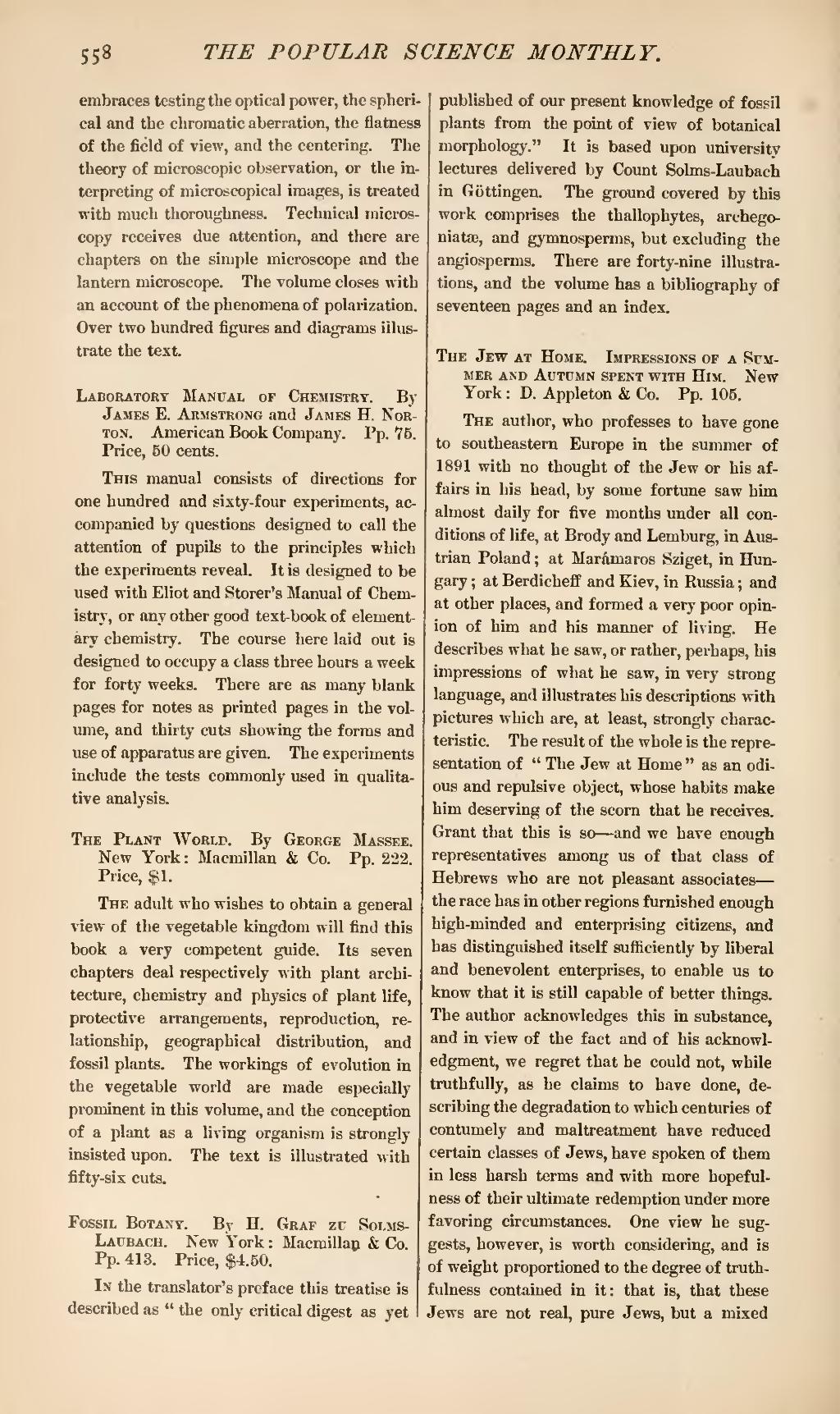embraces testing the optical power, the spherical and the chromatic aberration, the flatness of the field of view, and the centering. The theory of microscopic observation, or the interpreting of microscopical images, is treated with much thoroughness. Technical microscopy receives due attention, and there are chapters on the simple microscope and the lantern microscope. The volume closes with an account of the phenomena of polarization. Over two hundred figures and diagrams illustrate the text.
Laboratory Manual of Chemistry. By James E. Armstrong and James H. Norton. American Book Company. Pp. 75. Price, 50 cents.
This manual consists of directions for one hundred and sixty-four experiments, accompanied by questions designed to call the attention of pupils to the principles which the experiments reveal. It is designed to be used with Eliot and Storer's Manual of Chemistry, or any other good text-book of elementary chemistry. The course here laid out is designed to occupy a class three hours a week for forty weeks. There are as many blank pages for notes as printed pages in the volume, and thirty cuts showing the forms and use of apparatus are given. The experiments include the tests commonly used in qualitative analysis.
The Plant World. By George Massee. New York: Macmillan & Co. Pp. 222. Price, $1.
The adult who wishes to obtain a general view of the vegetable kingdom will find this book a very competent guide. Its seven chapters deal respectively with plant architecture, chemistry and physics of plant life, protective arrangements, reproduction, relationship, geographical distribution, and fossil plants. The workings of evolution in the vegetable world are made especially prominent in this volume, and the conception of a plant as a living organism is strongly insisted upon. The text is illustrated with fifty-six cuts.
Fossil Botany. By H. Graf zu SolmsLaubach. New York: Macmillan & Co. Pp. 413. Price, $4.50.
In the translator's preface this treatise is described as "the only critical digest as yet published of our present knowledge of fossil plants from the point of view of botanical morphology." It is based upon university lectures delivered by Count Solms-Laubach in Göttingen. The ground covered by this work comprises the thallophytes, archegoniatæ, and gymnosperms, but excluding the angiosperms. There are forty-nine illustrations, and the volume has a bibliography of seventeen pages and an index.
The Jew at Home. Impressions of a Summer and Autumn spent with Him. New York: D. Appleton & Co. Pp. 105.
The author, who professes to have gone to southeastern Europe in the summer of 1891 with no thought of the Jew or his affairs in his head, by some fortune saw him almost daily for five months under all conditions of life, at Brody and Lemburg, in Austrian Poland; at Marámaros Sziget, in Hungary; at Berdicheff and Kiev, in Russia; and at other places, and formed a very poor opinion of him and his manner of living. He describes what he saw, or rather, perhaps, his impressions of what he saw, in very strong language, and illustrates his descriptions with pictures which are, at least, strongly characteristic. The result of the whole is the representation of "The Jew at Home" as an odious and repulsive object, whose habits make him deserving of the scorn that he receives. Grant that this is so and we have enough representatives among us of that class of Hebrews who are not pleasant associates the race has in other regions furnished enough high-minded and enterprising citizens, and has distinguished itself sufficiently by liberal and benevolent enterprises, to enable us to know that it is still capable of better things. The author acknowledges this in substance, and in view of the fact and of his acknowledgment, we regret that he could not, while truthfully, as he claims to have done, describing the degradation to which centuries of contumely and maltreatment have reduced certain classes of Jews, have spoken of them in less harsh terms and with more hopefulness of their ultimate redemption under more favoring circumstances. One view he suggests, however, is worth considering, and is of weight proportioned to the degree of truthfulness contained in it: that is, that these Jews are not real, pure Jews, but a mixed
